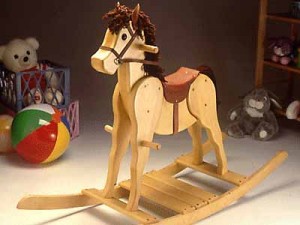
What follows is a passage from the draft of the book about my No Impact project. I thought you might enjoy a glimpse into my progress. The draft, by the way, is turned in and I await comments from my editor at Farrar, Straus & Giroux.
This passage is about some experiences we had in the “no buying anything new” part of the project. The idea was to try and purchase what we needed without causing any new resources to be taken from the ground or trees to be cut down. So everything we bought was second hand.
As we enter this scene, we had just dropped off some old clothes at a thrift store run by Housing Works:
And when we dropped the clothes off we saw a neat, rocking horse handmade from wood by someone’s grandfather. It had a name stenciled on it: Jake. The name was obviously the name of the child it had been made for, which gave us pause, but we just decided that it would be the name of the horse itself and we bought it for Isabella.
Now we were on the other end of the secondhand stuff cycle, from gifter to giftee. Instead of feeling, as I might have expected, like the used rocking horse was grubby, we felt like it was alive with history and human connection. It wasn’t anonymous and plastic from the toy store. It was the byproduct of the love of some grandfather, presumably, for a grandchild.
To bring it home had a much different feeling than to bring home something from toy store. Instead of giving her a piece of molded goop that had come out of an oil well, we gave her the product of love that had come out of an old man’s heart. Which would I rather Isabella held in her hands and had in her life?
This is the kind of commerce not where you feel like you are parted from your hard-earned money for something you don’t even like and of whose value you are suspicious. This is not the exchange of merely money for goods.
The nostalgic gift of the horse to Housing Works by the parents of children now grown. Our money gladly paid because we know it will go to the homeless. The memory of a grandfather’s love. A respect for planetary resources. My little girl laughing and rocking and trying to get our dog to get on.
This is not commerce. This is not profit extraction where you need to be sure that you are not paying too high a price and worry forever that you’ve been had.
This is not meaningless consumption but meaningful exchange. It is the exchange of human connection. It’s trade. It’s value. This is not buyer beware. It’s buyer be human. This is God’s Grace. This is the meaning of life.
*********
I’m thinking of Steffen Schneider, head farmer of Hawthorne Valley farm would tell me a couple of months later when I went to visit his farm. Hawthorne Valley is “biodynamic.” That is to say, at the center of Steffen’s philosophy of farming is an idea, developed by Rudolf Steiner that the farm is one big living organism. In the case of Hawthorne Valley, the beating heart of that organism is the dairy herd.
The herd grazes all day on 60 acres [this figure is inaccurate, by the way] of grass and once a day the cows are brought in to be milked. The manure collected in the cowsheds is composted and finally will become the only fertilizer for the 14-acre vegetable garden. But as Steffen explained it to me, it wasn’t that the manure just fertilized. There was something more esoteric carried by the manure that synthetic chemical fertilizers could never carry. Life.
First of all, the cows ate the living grass, which carried the life force of the earth, the organisms within the earth, the rain, the clouds, the sun, the entire universe and the grass itself. Then, too, the grass as the cows chewed it and it worked its way through the their digestive tracts collected the life force of the cows themselves. Putting the manure of the cows on the 14-acre vegetable garden concentrated the life force of 60 acres in one place, like focusing the sun with a magnifying glass.
This carrying of life force, maybe explains my little girl’s rocking horse and why I feel so sentimental about it. This means being part of a whole different kind of web.
Later we would find, in a little boutique in a flea market on 26th Street, a Louis Vitton blue and white striped shirt. For Michelle. She needed a little lift, she said, a little hark back to the shopping days. At the market, the boutique owner, a man, said to us “I probably shouldn’t tell you this but the shirt belonged to an old drag queen who died.” She had an act. She was a drag queen. She died.
Michelle wears the shirt and celebrates the drag queen’s life.
How esoteric is this? How corny? But I would just love to find the grandfather who made that rocking horse and throw my arms around him and thank him for his heart. I never knew the drag queen but she conjures a wonderful brew of tragedy and a terrific pulse of life. The tragedy of a difficult path. The pulse that will not be suppressed. I want to hold her too. I want to save her life.
This is not consumption. This is participation.
And when I see Michelle in that striped shirt, and I think of saving the drag queen’s life, I finally realize that when we bought that shirt, we did.